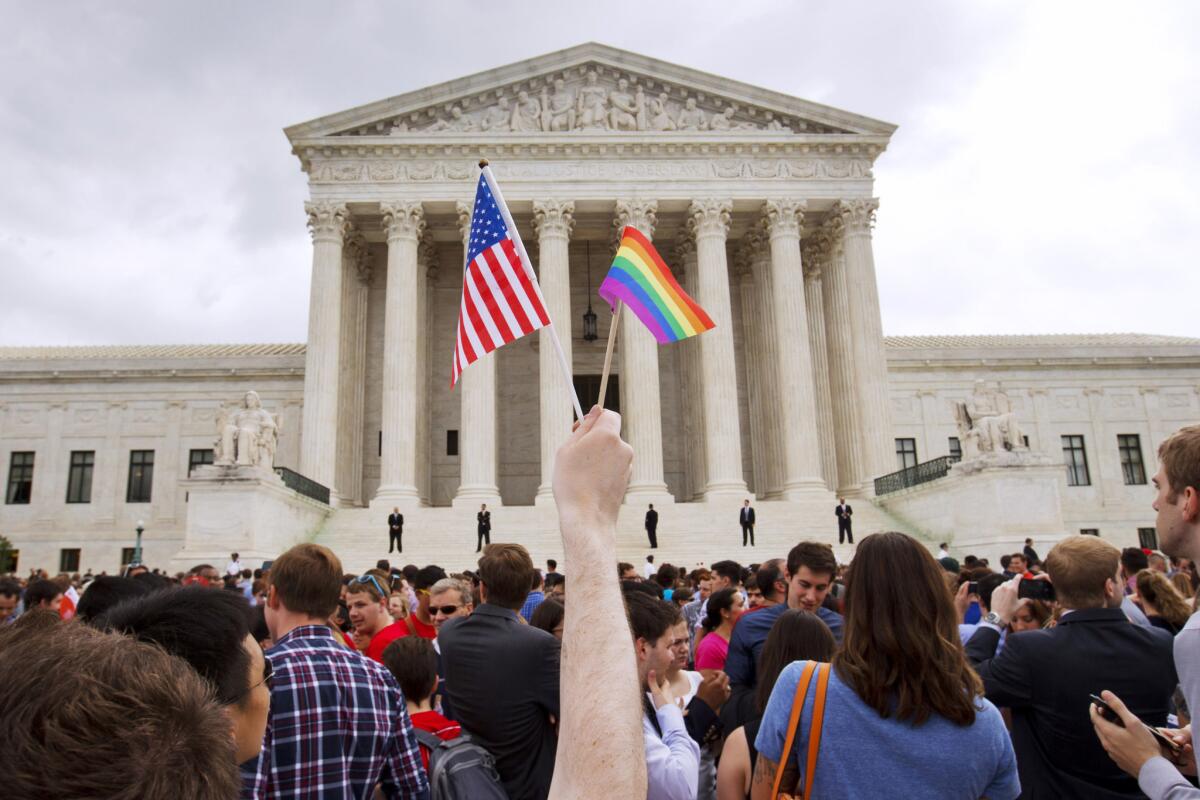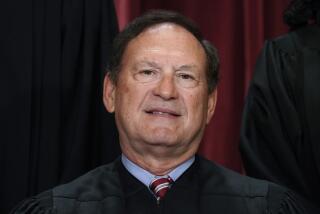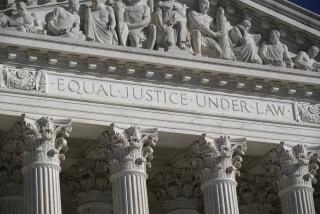Editorial: Doesn’t the 1st Amendment apply outside the Supreme Court?

A man holds a U.S. and a rainbow flag outside the Supreme Court on June 26, after the court legalized gay marriage nationwide. A federal appeals court ruled Friday that the Supreme Court can keep protesters off its marble plaza without violating their constitutional right to free speech.
From race relations to abortion to gay marriage, the Supreme Court plays a crucial role in American life. So it’s understandable that activists want to demonstrate on the grand plaza in front of the court’s building. Such a majestic backdrop lends force to a protest and increases the possibility that it will attract public attention.
Ignoring those realities and adopting a crabbed view of the 1st Amendment, the U.S. Court of Appeals for the District of Columbia Circuit last week upheld a law that bars demonstrators from gathering on the plaza, an oval terrace that is 252 feet long (at the largest part of the oval) and 98 feet wide. By contrast, under a 1972 Supreme Court ruling, demonstrators are allowed on the grounds of the U.S. Capitol.
The decision reversed a lower court ruling in favor of Harold Hodge Jr., an anti-police-brutality protester who was arrested in 2011 when he refused to leave the court grounds. Hanging from Hodge’s neck was a sign reading: “The U.S. Gov. Allows Police To Illegally Murder And Brutalize African Americans and Hispanic People.”
Writing for a three-judge panel, Judge Sri Srinivasan concluded that the plaza wasn’t a public forum (even though tourists mingle there and attorneys holds news conferences in front of the court’s steps). He then said that the prohibition on protesters was justified because it furthers the government’s interests in “preserving the appearance and actuality of a judiciary unswayed by public opinion and pressure.”
This priggish rationalization ignores the fact that, like all federal judges, Supreme Court justices have life tenure and are blissfully free to disregard public opinion if they choose. Moreover, even where state judges are concerned, the Supreme Court has held that the 1st Amendment protects the right to comment on the behavior of judges and offer them advice.
In Bridges vs. California, a landmark 1941 case, the court overturned a contempt-of-court citation against this newspaper for an editorial urging a judge not to grant probation to two union members convicted of assaulting nonunion truck drivers and instead to send them to prison. Justice Hugo Black said that to treat the editorial as a threat to the judicial process “would be to impute to judges a lack of firmness, wisdom or honor, which we cannot accept as a major premise.”
If Hodge ultimately appeals to the Supreme Court, the justices should rule in his favor. They know better than anybody else that demonstrations on their doorstep are not a threat to judicial independence. They are, however, an example of something the court has repeatedly celebrated in its 1st Amendment decisions: the principle that “debate on public issues should be uninhibited, robust, and wide-open.”
Follow the Opinion section on Twitter @latimesopinion and Facebook
More to Read
A cure for the common opinion
Get thought-provoking perspectives with our weekly newsletter.
You may occasionally receive promotional content from the Los Angeles Times.






